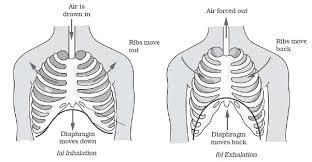Diaphragmatic breathing focuses on completely filling your lungs and exercising your diaphragm while breathing. The diaphragm is a muscle that sits at the bottom of your chest cavity. When you take a deep breath in, your diaphragm contracts and lowers, increasing the amount of space in the chest cavity for the lungs. The lungs are then able to fill with air. When we breath out, the diaphragm relaxes, decreasing the amount of space in the chest cavity and forcing the air out of the lungs as shown:

Unfortunately, as we age we tend to rely less on the diaphragm for breathing and more on the muscles of the back, neck and shoulders. Things such as slouching, stress and holding in the stomach force us to use more shallow chest breathing. Since the diaphragm is a muscle and needs to be used to remain strong using these accessory muscle weakens the diaphragm over time and air builds up in the lungs. This air buildup forces the diaphragm down and leads to an even further weakening of the muscle. Diaphragmatic breathing strengthens the diaphragm and helps force this air buildup out of the lungs. This leads to more efficient respiration and a better exchange of oxygen.
Diaphragmatic breathing takes a little practice. When you are first learning it is best to lay on the floor with your knees bent and one hand on top of your chest while the other hand rests on your belly. Take a deep breath in and concentrate on filling your lungs and expanding your belly. The hand that is on your chest should not move, but the one on your stomach should rise up as your diaphragm expands. Then slowly exhale through pursed lips while noticing how the hand on your stomach falls. Continue to breath in and out slowly for 5-10 minutes. Once you have perfected this technique you will be able to do deep breathing while seated in a chair. Repeat this sequence 3-4 times daily, or whenever you need a little relaxation.
Benefits of diaphragmatic breathing include:
- Decreased heart rate and blood pressure
- Increased core muscle stability
- Relaxation of the body and lowered cortisol
- Increased ability to tolerate intense exercise
- Improved respiratory capacity
- Slowed rate of breathing and less energy expenditure
- Improved quality of life for COPD patients and asthmatics
As you can see this simple breathing exercise can yield great benefits in only a few minutes a day. If you are interested in learning this technique in person or in other ways to improve your health through movement give me a call today!
www.ExercisePrescriptionLV.com